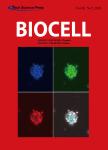RNA-sequencing indicates high hemocyanin expression as a key strategy for cold adaptation in the Antarctic amphipod Eusirus *** clade g3
作者机构:Department of Life SciencesUniversity of TriesteTrieste34127Italy Department of BiologyUniversity of PadovaPadova35131Italy
出 版 物:《BIOCELL》 (生物细胞(英文))
年 卷 期:2021年第45卷第6期
页 面:1611-1619页
核心收录:
基 金:the Italian Program of Antarctic Research(Grant No.PNRA16_00099)
主 题:Antarctica Cold adaptation Hemocyanin Amphipod Transcriptome
摘 要:We here report the de novo transcriptome assembly and functional annotation of Eusirus *** clade g3,providing the first database of expressed sequences from this giant Antarctic ***-sequencing,carried out on the whole body of a single juvenile individual likely undergoing molting,revealed the dominant expression of *** mRNAs encoding these oxygen-binding proteins cumulatively accounted for about 40%of the total transcriptional effort,highlighting the key biological importance of high hemocyanin production in this Antarctic amphipod *** speculate that this observation may mirror a strategy previously described in Antarctic cephalopods,which compensates for the decreased ability to release oxygen to peripheral tissues at sub-zero temperatures by massively increasing total blood hemocyanin content compared with temperate *** preliminary results will undoubtedly require confirmation through proteomic and biochemical analyses aimed at characterizing the oxygen-binding properties of *** clade g3 hemocyanins and at investigating whether other Antarctic arthropod species exploit similar adaptations to cope with the challenges posed by the extreme conditions of the polar environment.



